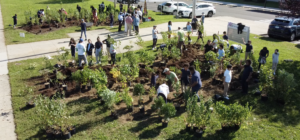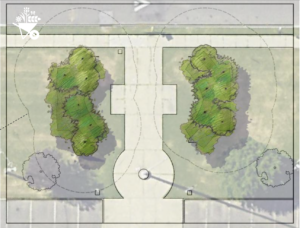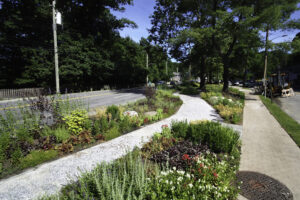By Bran Gunther and Jeffrey Rothfeder

At a Con Ed campus in Rye, New York, two Micro Forests have just been planted. Each is 10 feet by 10 feet and includes four canopy trees, thirty-two understory trees, and thirty-two shrubs. This is a first for Westchester but in the coming years we anticipate that Micro Forests will sprout up everywhere throughout the county in people’s backyards, corporate campuses, schools, on the river, on hills and mountains and at retail sites.
Simply put, Micro Forests are groups of densely packed trees, shrubs and plants, which can turn blighted and unused areas into beneficial environments that are attractive and robust natural habitats with enduring ecological improvements. The idea for Micro Forests dates to the 1970s but is having a moment today. Back then, Japanese landscape architect and botanist Akira Miyawaki observed that stands of native trees in metropolitan areas planted closely together grew much faster – as much as ten times more rapidly – than other forests with more space. And as these clustered trees mature, invasive plants are shaded out.
The environmental benefits of this arrangement are immense. Micro Forests absorb stormwater and rarely wash out. They are immediate sources for birds and insects roaming for new space and new food. They capture carbon through the trees, shrubs, and soil. Perhaps most importantly, they create cool spots in communities with little tree canopy cover, where the urban heat island effect is most intensified, and lower surrounding temperatures. They provide nearly instantaneous beauty in areas with little green space.
The success of Micro Forests is based on two fundamental things:
- Planting trees and shrubs as tightly as possible. As much as 1,400 saplings in one basketball court.
- Soil amendments, in the form of compost and organic fertilizers, as needed.

Micro Forests have already had a big impact in Cambridge, Massachusetts, which has pioneered their implementation among cities. And New York City recently announced that it will be planting its first Micro Forest in Roosevelt Island on the East River. Meanwhile, a series of schools in Bridgeport, Connecticut has also embraced the concept. Working with the Connecticut-based land trust Aspetuck and the Bridgeport Public School system, ecological landscapers Plan it Wild planted a 300 square foot Micro Forest of 6 canopy trees, 48 understory trees and 96 shrubs at a Bridgeport school. Since Bridgeport sits on the Long Island Sound, tree species that can handle windy and salty conditions were used, like hackberry and willow. Micro Forests further upland and inland will generally include maples and oaks, as well as serviceberry and sassafras. The school’s students helped landscapers plant the Micro Forest, an approach that Miyawaki recommends to create a personal bond between the school and the forest.
The Micro Forest immediately changed the school’s landscape—a baby forest, clearly visible from across the campus, had taken root. In a sea of turf, the stems, branches, leaves, and the varied heights of the plants stood out. At another site, a Micro Forest stands at the entrance to a school, transforming what was an open flat and concrete unwelcoming space into rich, open and friendly native habitat.
Bram Gunther is VP and Jeffrey Rothfeder is Co-founder at Plan it Wild, an ecological landscape design company that specializes in rewilding residential and public spaces.







This is Wonderful !!!